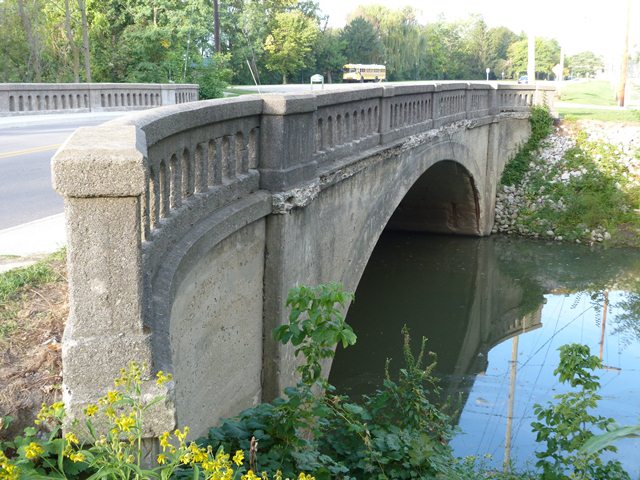We Recommend:
Bach Steel - Experts at historic truss bridge restoration.
4th Street Bridge
Allen County Bridge 525

Primary Photographer(s): Nathan Holth and Rick McOmber
Bridge Documented: June 3, 2012
Fort Wayne: Allen County, Indiana: United States
1921 By Builder/Contractor: Herman Tapp Construction Company of Fort Wayne, Indiana and Engineer/Design: Asa Waters Grosvenor of Fort Wayne, Indiana
Not Available or Not Applicable
55.0 Feet (16.8 Meters)
65.0 Feet (19.8 Meters)
30 Feet (9.14 Meters)
1 Main Span(s)
200261

View Information About HSR Ratings
Bridge Documentation
View Archived National Bridge Inventory Report - Has Additional Details and Evaluation
View Historical Biographies Discussing Asa Waters Grosvenor
View A Historical Article About The Construction of the Similar Harrison Street Bridge

This bridge is a late but rare example of a concrete arch bridge using the Melan style of reinforcing. Melan reinforcing uses solid steel arch ribs (either rolled or built-up) embedded in concrete to providing a reinforcing system as opposed to the network of steel rods (rebar) used in the majority of reinforced concrete bridges. Melan arch bridges were more common in the earlier years of concrete arch bridge construction. Examples from after 1915 like this one were uncommon. However, Asa Waters Grosvenor, who designed many of Fort Wayne's concrete arch bridges, appears to have had an affinity for Melan reinforcing. Grosvenor's Melan arch bridges used steel ribs that were built-up latticed beams. While the small 4th Street Bridge likely did not receive much attention in the engineering community, an earlier and larger (and now demolished and replaced) bridge on Harrison Street in Fort Wayne was also designed by Grosvenor. An article about this bridge included a photo, shown to the right, which shows the Melan reinforcing laid out on the falsework, awaiting the concrete pour.
The 4th Street Bridge bridge is in good physical condition overall. However, there is some spalling that, while undesirable, is of interest to understanding the bridge because it has revealed the bottom of some of the Melan reinforcing. The photo to the left shows the exposed sections of a couple of the ribs.
This bridge retains original concrete balustrade railings. Lighting was originally mounted on top of the railings, but this has been removed. This bridge originally had a beautiful brick deck that has been overlayed with asphalt. Suggested future preservation work is to repair the spalling on the arch, restore the bridge so it again displays a brick deck, and reinstall replica lighting on the bridge.
Information and Findings From DHPA Historic Bridge SurveyStatement of Significance This rather late Grosvenor design appears to be rather conventional in form and modestly decorated. The bridge does retain its architectural integrity. Architectural Description A.W. Grosvenor of Fort Wayne designed a number of concrete arches which different contractors built in and around Allen County in the second decade of the 20th Century. About half a dozen bridges he designed have survived. Other Information In the second decade of the twentieth century, A. W. Grosvenor of Fort Wayne designed about a half-dozen reinforced-concrete arched structures built in the region. In June 1919, four firms bid to build the Fourth Street Bridge. Two proposed a steel-truss structure on Rochester Bridge Company plans. Offering the lowest bid to built on the Grosvenor plans, the Herman Tapp Construction Company of Fort Wayne won a contract from the commissioners at $20,990. The arch ring is segmental with a 13-foot rise. "The reinforcement will consist of the Melan type of riveted lattice girders imbedded in the concrete of the arch ring." Solid spandrel walls retain the earth fill and originally carried a brick roadway, now covered with asphalt. 5-foot and 10-inch sidewalks flank the roadway and are in turn bordered by coped parapet rails with open-arch panels. This rather late Grosvenor design appears to be rather conventional in form and modestly decorated. The bridge retains its architectural integrity. References: Butler, Fairman & Seufert, Inc., Bridge Inspection/Reinspection Report: Allen County (Indianapolis, 1973, 1977, 1981). Bridge nameplate. Allen County, "Commissioners Record," 13: 230; 14: 401-402. Allen County, "Old Bridges" (Surveyor's Office), 13E: 14. "Construction News," Engineering News, 7 September 1916: 123; 20 September 1917: 120. Two bridge plates: Bridge Considered Historic By Survey: Yes |
This bridge is tagged with the following special condition(s): Melan
![]()
Photo Galleries and Videos: 4th Street Bridge
Bridge Photo-Documentation
Original / Full Size PhotosA collection of overview and detail photos. This gallery offers photos in the highest available resolution and file size in a touch-friendly popup viewer.
Alternatively, Browse Without Using Viewer
![]()
Bridge Photo-Documentation
Mobile Optimized PhotosA collection of overview and detail photos. This gallery features data-friendly, fast-loading photos in a touch-friendly popup viewer.
Alternatively, Browse Without Using Viewer
![]()
Maps and Links: 4th Street Bridge
Coordinates (Latitude, Longitude):
Search For Additional Bridge Listings:
Bridgehunter.com: View listed bridges within 0.5 miles (0.8 kilometers) of this bridge.
Bridgehunter.com: View listed bridges within 10 miles (16 kilometers) of this bridge.
Additional Maps:
Google Streetview (If Available)
GeoHack (Additional Links and Coordinates)
Apple Maps (Via DuckDuckGo Search)
Apple Maps (Apple devices only)
Android: Open Location In Your Map or GPS App
Flickr Gallery (Find Nearby Photos)
Wikimedia Commons (Find Nearby Photos)
Directions Via Sygic For Android
Directions Via Sygic For iOS and Android Dolphin Browser
USGS National Map (United States Only)
Historical USGS Topo Maps (United States Only)
Historic Aerials (United States Only)
CalTopo Maps (United States Only)


